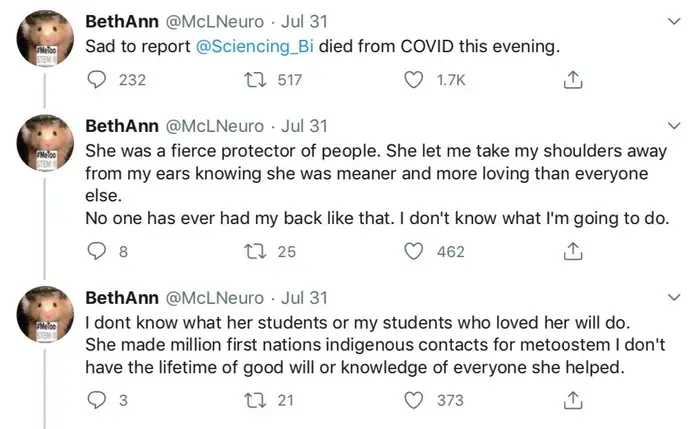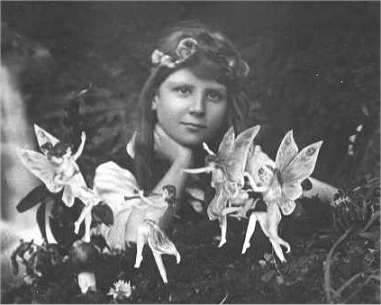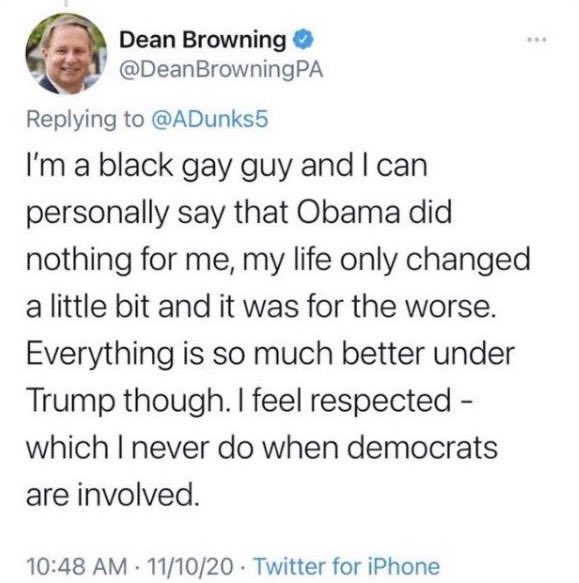Inauthenticity
Contents
6.3. Inauthenticity#
In 2016, the Twitter account @Sciencing_Bi was created by an anonymous bisexual Native American Anthropology professor at Arizona State University (ASU). She talked about her experiences of discrimination and about being one of the women who was sexually harassed by a particular Harvard professor. She gained a large Twitter following among academics, including one of the authors of this book, Kyle.
Separately, in 2018 during the MeToo movement, one of @Sciencing_Bi’s friends, Dr. BethAnn McLaughlin (a white woman), co-founded the MeTooSTEM non-profit organization, to gather stories of sexual harassment in STEM (Science, Technology, Engineering, Math). Kyle also followed her on Twitter until word later spread of Dr. McLaughlin’s toxic leadership and bullying in the MeTooSTEM organization (Kyle may have unfollowed @Sciencing_Bi at the same time for defending Dr. McLaughlin, but doesn’t remember clearly).
Then, in April 2020, in the early days of the COVID pandemic, @Sciencing_Bi complained of being forced to teach in person at ASU when it wasn’t safe, and then began writing about their COVID symptoms.

Fig. 6.2 Tweet from @Sciencing_Bi complaining about covid, sexual harassment (Title IX) descrimination for their race (BIPOC), and mentioning that they are still posting anonymously. (screenshot source)#
On July 31st, Dr. McLaughlin announced that @Sciencing_Bi had died of COVID.

Fig. 6.3 Tweet from Dr. McLaughlin reporting that @Sciencing_Bi died of COVID. (screenshot source)#
Many academics on Twitter expressed sympathy and outrage over what had happened to @Sciencing_Bi. Dr. McLaughlin held a memorial service for @Sciencing_Bi online via Zoom.
A few people showed up to Dr. McLaughlin’s online Zoom memorial service for @Sciencing_Bi, but the guests felt something was off.
Afterward, Mr. Eisen began to search for any evidence that @Sciencing_Bi had been a real person. He could not find any.
“The combination of the weird things that were happening on the call and looking at the tweets and seeing how much they circled BethAnn, it just became obvious to me,” he said. “‘Oh, [@Sciencing_Bi] is BethAnn.’”
Arizona State University confirmed that they had no professors who matched the description of @Sciencing_Bi. Dr. McLaughlin’s and @Sciencing_Bi’s accounts were suspended from Twitter for violating Twitter policies, and Dr. McLaughlin eventually confirmed that she had completely invented @Sciencing_Bi.
Many people were upset at being deceived, and at the many levels of inauthenticity of Dr. McLaughlin’s actions, such as:
Dr. McLaughlin pretended to be a person (@Sciencing_Bi) who didn’t exist.
Dr. McLaughlin, as a white woman, created an account where she pretended to be a Native American (see more on “pretendians”).
Dr. Mclaughlin put herself at the center of the MeToo movement as it related to STEM, but then Dr. Mclaughlin turned out to be a bully herself.
Dr. McLaughlin used the fake @Sciencing_Bi to shield herself from critizism. From the NYTimes article: “‘The fact that @Sci-Bi was saying all these things about BethAnn, saying that BethAnn had helped her, it didn’t make me trust BethAnn — but it made me less willing to publicly criticize her because I thought that public criticism would be felt by the people she was helping,’ he said. ‘Who turned out to be fake.’”
Though Dr. McLaughlin claimed a personal experience as a witness in a Title IX sexual harassment case, through the fake @Sciencing_Bi, she invented an experience of sexual harassment from a Harvard professor. This professor was being accused of sexual harassment by multiple real women, and these real women were very upset to find out that @Sciencing_Bi, who was trying to join them, was not a real person.
Dr. McLaughlin, through the @Sciencing_Bi account, pretended to have an illness she didn’t have (COVID). She made false accusations against Arizona State University’s role in the (fake) person getting sick, and she was able to get attention and sympathy through the fake illness and fake death of the fake @Sciencing_Bi.
Sources:
Sciencing_Bi & BethAnn McLaughlin Twitter Accounts Suspended in Bizarre Tale - The Heavy
She created a fake Twitter persona — then she killed it with COVID-19 - The Verge
6.3.1. Inauthentic Behaviors#
Inauthentic behavior is when the reality doesn’t match what is being presented. Inauthenticity has, of course, existed throughout human history, from Ea-nasir complaining in 1750 BCE that the copper he ordered was not the high quality he had been promised, to 1917 CE in England when Arthur Conan Doyle (the author of the Sherlock Holmes stories) was fooled by photographs that appeared to be of a child next to fairies.

Fig. 6.4 A 1917 photograph whose creators claimed was a photo of a child with fairies, proving that fairies exist (the fairies were actually cardboard cut-outs).#
There are many ways inauthnticity shows up on internet-based social media, such as:
Catfishing: Create a fake profile that doesn’t match the actual user, usually in an attempt to trick or scam someone
Sockpuppet (or a “burner” account): Creating a fake profile in order to argue a position (sometimes intentionally argued poorly to make the position look bad)

Fig. 6.5 US Congressional candidate Dean Browning in 2020 posting what appears to be a post intended for a sockpuppet account where he was pretending to be a gay Black man.#
Astroturfing: An artificially created crowd to make something look like it has popular support
Parody accounts: An account that is intentionally mimicking a person or position, but intended to be understood as fake.
Various types of trolling, which we will cover in the next chapter
